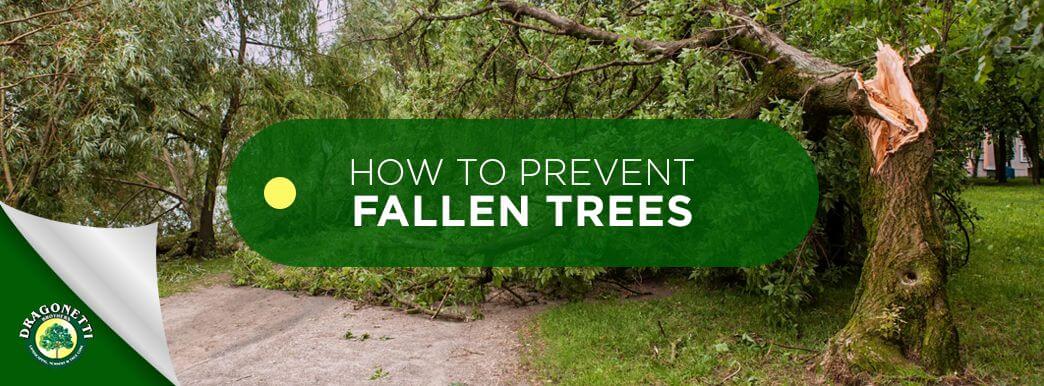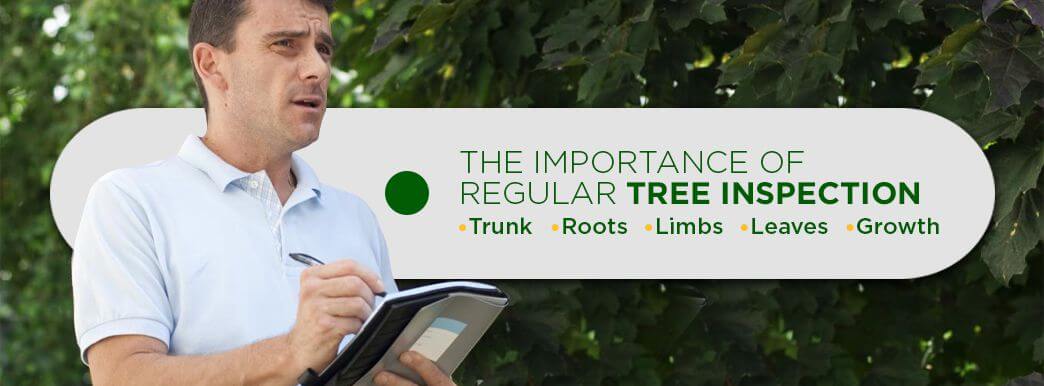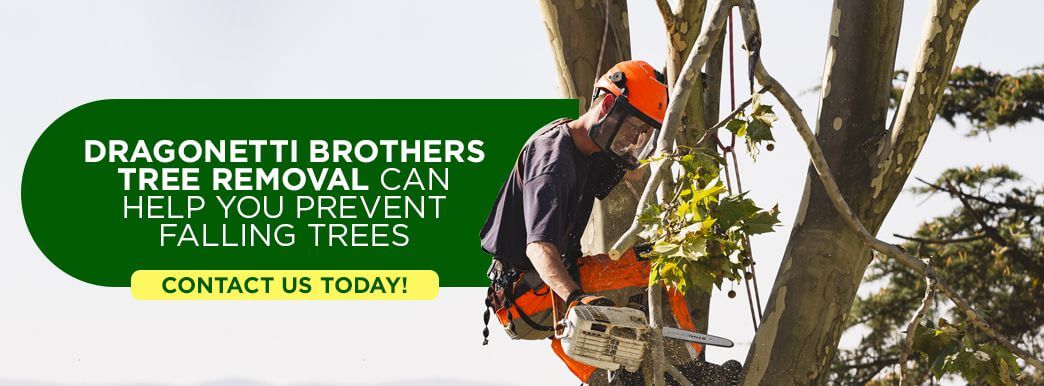
Trees are living organisms. Like any other living thing, they can become sick or damaged. These injuries can worsen over time, leading to tree decay and rot. These weakened trees are more susceptible to falling.
While removing the tree from your yard is certainly an option, it is not always desirable. Trees are beautiful and offer your home many benefits. They provide shade, help prevent soil erosion, buffer heavy noise pollution, increase your home’s property value and more.
Thankfully, there are several things you can do to prevent, anticipate and remedy a fallen tree.
THE IMPORTANCE OF REGULAR TREE INSPECTION

It is your legal responsibility to maintain any trees on your property. Should a tree fall and cause damage to a neighbor or their property, you could be held liable. Trees falling also pose a threat to your safety and the safety of your home. For this reason, regular tree inspection is crucial. The more familiar you are with the trees on your property, the more likely you are to notice any changes that could indicate a fall. When inspecting a tree, check the following spots thoroughly:
- Trunk: Examine the tree’s trunk for any wounds, holes or large cracks. Note any missing or peeling bark, as well as visible mushrooms, mold or insects. Make sure the trunk is firm to the touch and not soft.
- Roots: Check that all surface roots are expanding outward, away from the tree, and not tangling around the base or trunk.
- Limbs: Do not climb your tree to inspect limbs. Instead, conduct as much of your inspection from the ground as possible. Note any signs of decay, such as fungus or missing bark. Be cautious of any split or low-hanging branches, as they could fall. Branches growing around one another may also be cause for concern.
- Leaves: Before inspecting individual leaves, look toward the sky for a view of your tree’s general canopy coverage. If your tree is full and lush, that is a good sign. A sparse canopy is worth noting. When looking at the leaves, check for any signs of scorching from the sun or holes from insects. Make sure they are not browning or wilting prematurely. If a fruit tree is not producing fruit — or the fruit is too small or rotten — this could be a sign of a more significant issue.
- Growth: As you inspect your trees over time, track their progress. Are they growing as they should be? Are any previously noted concerns getting worse?
Take note of any changes and track their progress over time. Pay special attention to old or previously damaged trees and any trees located near standing structures. Consider consulting with a tree removal company. In addition to removal, they can provide pruning and maintenance services.
HOW TO PREVENT A TREE FROM FALLING
Preventative care is the best way to prolong your tree’s life and keep it from falling. Preventative tree maintenance can save you from having to deal with costly damage to your trees.
DO NOT OVERWATER
It is possible — and very common — to drown your tree roots. When roots receive too much water, they are unable to absorb oxygen. This leads to nutrition deficiencies and decay. The general rule is that a tree should receive 1- gallon of water for every inch it has in diameter. Unfortunately, it is easy to confuse the symptoms of underwatering with signs of overwatering. Symptoms of overwatering include sun-scorched or yellowed leaves, mushroom growth or loss of vitality.
One way to check for overwatering is to dig several inches into the dirt of the tree’s root zone. If the soil is damp, the tree is receiving too much water.
TRIM AND PRUNE REGULARLY

The best time to have your tree pruned is when it is dormant in the fall or winter — unless the cause for pruning is a rapidly spreading disease. There are several pruning techniques you can use to keep your tree in shape. Removing dead limbs is an especially important part of the pruning process. Decaying limbs can allow harmful insects or diseases to spread to the rest of the tree if left untouched. If you leave dead limbs to fall on their own, you also risk them hurting someone or damaging property on the way down.
SCHEDULE REGULAR MAINTENANCE
Regular tree maintenance and inspections are the best way to ensure your tree has a long, healthy life and your home is safe from dangerous tree falls. A professional tree removal company can climb your tree and inspect the parts of it that are out of reach. They will know what to look for and how to address any problems they find. They are trained to work safely, quickly and without damaging or disturbing your property in any way.
TREE SAFETY TIPS
The average tree weighs several tons. Something so strong and heavy should be handled with care for the sake of your family and property. Keep the following tree safety tips in mind:
- Never trim a tree on your own: Never attempt to trim, prune or remove a tree on your own, especially if its branches hang over a roof. If done incorrectly, heavy branches can fall on your home or your neighbors’ property and cause costly damage. Attempting to trim or remove a tree on your own can also lead to injury due to high falls or chainsaw accidents. Consulting a professional is the best way to ensure your safety and limit damage to the tree.
- Watch the weather: Keep an eye on weather forecasts. If you know a tree in your yard could pose a threat and are unable to make removal arrangements before a big storm is due, plan for you and your family to be away from your home during high winds. At the very least, be sure you stay in a room in the house that is as far from the dangerous tree as possible.
- Save dying trees: You may be able to nurse a sick tree back to health. If safe and possible, try to save a dying tree. If it lacks nutrients, fertilize it. If it is thirsty, water it. If it is drowning, reduce water runoff as much as possible. Inspect for and eliminate insect infestations.
- Remove when necessary: No matter how beautiful a tree is, if it poses a threat to your home and family, it is best to have it removed before it becomes dangerous. Contact a reputable tree removal company and request a removal quote.
IS MY TREE GOING TO FALL?

When it comes to the trees in your yard, know what to look for. A tree could be at risk for falling if:
- The trunk is leaning: Will a leaning tree always fall? Not necessarily. Trees that grow with a natural leaning trunk are not a problem. Ordinarily, straight trees that are leaning 15 degrees or more, however, are cause for concern.
- The roots are rotten: Soft, squishy tree trunks or growing fungi can be an indication of rotten tree roots. Other symptoms include slow growth, premature autumn coloring, leaf wilting and loose bark.
- Branches are dead or falling: Dead branches are a hazard due to their ability to fall at any given moment, but they are also a sign that something is wrong with your tree.
- The bark is missing: Missing or cracked tree bark represents a weak spot in your tree trunk.
- Branches are growing tightly: Tree branches should be growing in a broad U-shaped position. V-shaped branch formations can lead to weak, forked branches that cannot withstand strong wind.
WHEN ARE TREES LIKELY TO FALL?
Although no one can know for sure when a tree may fall, several factors increase the likelihood. These are:
- Damaged roots: A tree typically has 4 – 7 major roots in its root system. If even one of these becomes damaged, up to 25% of the root system can fail. Failing or damaged root systems lead to unhealthy, unstable trees.
- Rotten roots: Many issues can lead to root rot, but excessive moisture due to poor drainage is the most common cause. There are no chemical treatments for root rot, but the disease can be prevented by planting trees in well-drained places — such as in raised beds — and away from downspouts and groundwater.
- Shallow or unestablished root systems: It is possible that your tree was not correctly planted or was unable to establish secure root systems. Over-mulching is a common cause of this.
- Trauma: Trauma can come in many forms, including impact sustained from car accidents, lawnmowers or other fallen trees that damage the tree’s trunk and cause it to lean or fall.
CONSTRUCTION AND TREE DAMAGE
During construction projects, damaged root systems are the number one cause of damaged trees. Tree roots extend one to three times the radius of the branches, making it easy for the root system to accidentally become damaged during digging or excavating.
To avoid damaging your trees, keep them in mind when planning your construction project. Some ways to minimize tree damage during construction projects are:
- Avoid working during hot or dry weather when trees are at their most vulnerable.
- When necessary, go around the tree instead of under it.
- Mark a root protection zone around your tree with plastic or barbed wire fences. Consider filling the area with mulch.
- Avoid piling excess soil on or near the roots of your tree. Soil fills may suffocate the root system or keep it from absorbing nutrients.
- Choose a reputable contractor who understands and values the protection of your trees during the construction process.
- Monitor your tree afterward. Keep in mind that it could take your tree several years to adjust to any substantial changes in your yard’s infrastructure. Watch for any changes or signs of damage.
STORMS AND TREE DAMAGE
Storms — and storm aftermath — can be a frightening time for tree owners. The three most significant threats to your tree during this time are windthrow, lightning strikes, and overly saturated soil.
Windthrow takes one of two forms — insipient windthrow and catastrophic windthrow. Insipient windthrow is a gradual movement over several years, where wind from storms slowly breaks down your tree. Catastrophic windthrow is when a tree is uprooted or traumatized.
Lightning can inflict damage on your tree, ranging from minor injury to destruction. It is possible to protect your tree from lightning using a copper lightning protection system.
Help waterlogged trees drain by diverting any standing water away from your tree and its root system. Temporarily remove any mulch from around your tree, as it will seal moisture in.
When a big storm passes, it is a good idea to give your local tree removal experts a call even if the tree has not fallen. They can take a look at your tree and check for signs of unseen damage.

